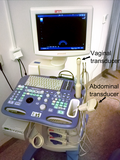Vaginal ultrasonography
Vaginal Ultrasonography[edit]


Vaginal ultrasonography is a type of pelvic ultrasound used by medical professionals to examine female reproductive organs. This includes the uterus, ovaries, fallopian tubes, cervix, and the vagina.
Procedure[edit]
Vaginal ultrasonography is performed using a transducer, which is a small, wand-like device that is inserted into the vagina. The transducer emits sound waves that bounce off the internal organs, creating images on a monitor. This procedure is often referred to as a transvaginal ultrasound.
The patient is usually asked to lie on her back with her feet in stirrups, similar to a gynecological examination. A protective cover is placed over the transducer, and a small amount of lubricant is applied to ease insertion. The procedure typically takes about 30 minutes and is generally painless, though some women may experience mild discomfort.
Uses[edit]
Vaginal ultrasonography is used for a variety of diagnostic purposes, including:
- Evaluating unexplained pelvic pain
- Investigating abnormal vaginal bleeding
- Monitoring ovarian cysts
- Assessing uterine fibroids
- Diagnosing ectopic pregnancy
- Monitoring fetal development in early pregnancy
Advantages[edit]
Compared to abdominal ultrasound, vaginal ultrasonography provides a clearer and more detailed view of the pelvic organs. This is because the transducer is closer to the organs being examined, allowing for higher resolution images. It is particularly useful in early pregnancy and for evaluating conditions that affect the uterus and ovaries.
Limitations[edit]
While vaginal ultrasonography is a valuable diagnostic tool, it has limitations. It may not be suitable for women who have never been sexually active or for those with certain medical conditions. Additionally, it may not provide sufficient information in cases where a broader view of the pelvic area is needed.
Related Pages[edit]
References[edit]
<references group="" responsive="1"></references>
-
Transvaginal ultrasonography device
-
Vaginal ultrasound
Ad. Transform your life with W8MD's Budget GLP-1 injections from $75


W8MD offers a medical weight loss program to lose weight in Philadelphia. Our physician-supervised medical weight loss provides:
- Weight loss injections in NYC (generic and brand names):
- Zepbound / Mounjaro, Wegovy / Ozempic, Saxenda
- Most insurances accepted or discounted self-pay rates. We will obtain insurance prior authorizations if needed.
- Generic GLP1 weight loss injections from $75 for the starting dose.
- Also offer prescription weight loss medications including Phentermine, Qsymia, Diethylpropion, Contrave etc.
NYC weight loss doctor appointmentsNYC weight loss doctor appointments
Start your NYC weight loss journey today at our NYC medical weight loss and Philadelphia medical weight loss clinics.
- Call 718-946-5500 to lose weight in NYC or for medical weight loss in Philadelphia 215-676-2334.
- Tags:NYC medical weight loss, Philadelphia lose weight Zepbound NYC, Budget GLP1 weight loss injections, Wegovy Philadelphia, Wegovy NYC, Philadelphia medical weight loss, Brookly weight loss and Wegovy NYC
|
WikiMD's Wellness Encyclopedia |
| Let Food Be Thy Medicine Medicine Thy Food - Hippocrates |
Medical Disclaimer: WikiMD is not a substitute for professional medical advice. The information on WikiMD is provided as an information resource only, may be incorrect, outdated or misleading, and is not to be used or relied on for any diagnostic or treatment purposes. Please consult your health care provider before making any healthcare decisions or for guidance about a specific medical condition. WikiMD expressly disclaims responsibility, and shall have no liability, for any damages, loss, injury, or liability whatsoever suffered as a result of your reliance on the information contained in this site. By visiting this site you agree to the foregoing terms and conditions, which may from time to time be changed or supplemented by WikiMD. If you do not agree to the foregoing terms and conditions, you should not enter or use this site. See full disclaimer.
Credits:Most images are courtesy of Wikimedia commons, and templates, categories Wikipedia, licensed under CC BY SA or similar.
Translate this page: - East Asian
中文,
日本,
한국어,
South Asian
हिन्दी,
தமிழ்,
తెలుగు,
Urdu,
ಕನ್ನಡ,
Southeast Asian
Indonesian,
Vietnamese,
Thai,
မြန်မာဘာသာ,
বাংলা
European
español,
Deutsch,
français,
Greek,
português do Brasil,
polski,
română,
русский,
Nederlands,
norsk,
svenska,
suomi,
Italian
Middle Eastern & African
عربى,
Turkish,
Persian,
Hebrew,
Afrikaans,
isiZulu,
Kiswahili,
Other
Bulgarian,
Hungarian,
Czech,
Swedish,
മലയാളം,
मराठी,
ਪੰਜਾਬੀ,
ગુજરાતી,
Portuguese,
Ukrainian

